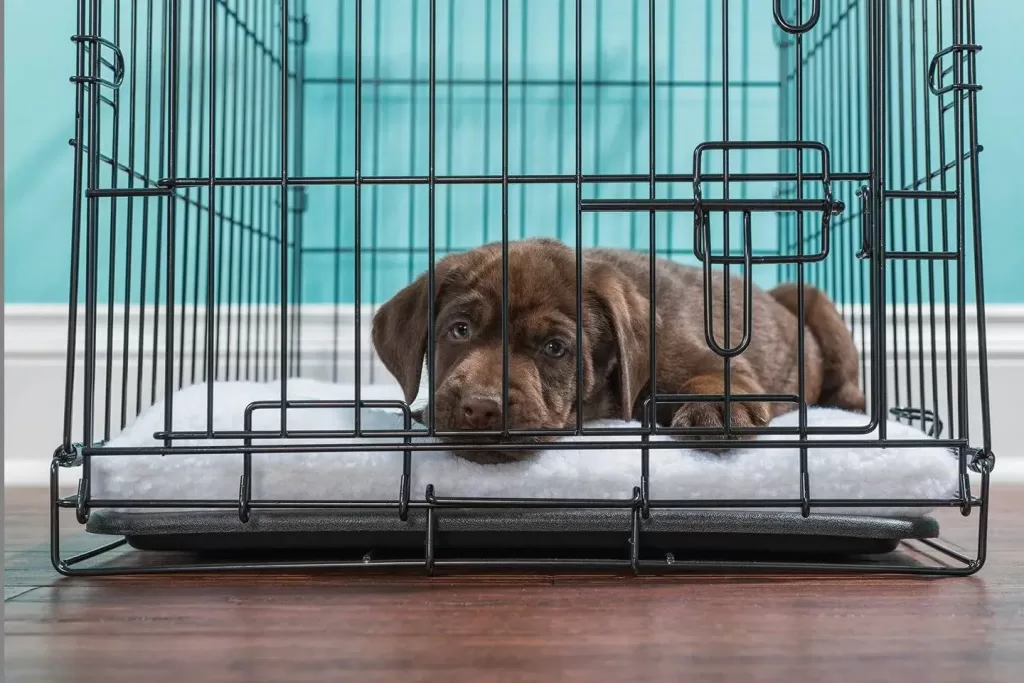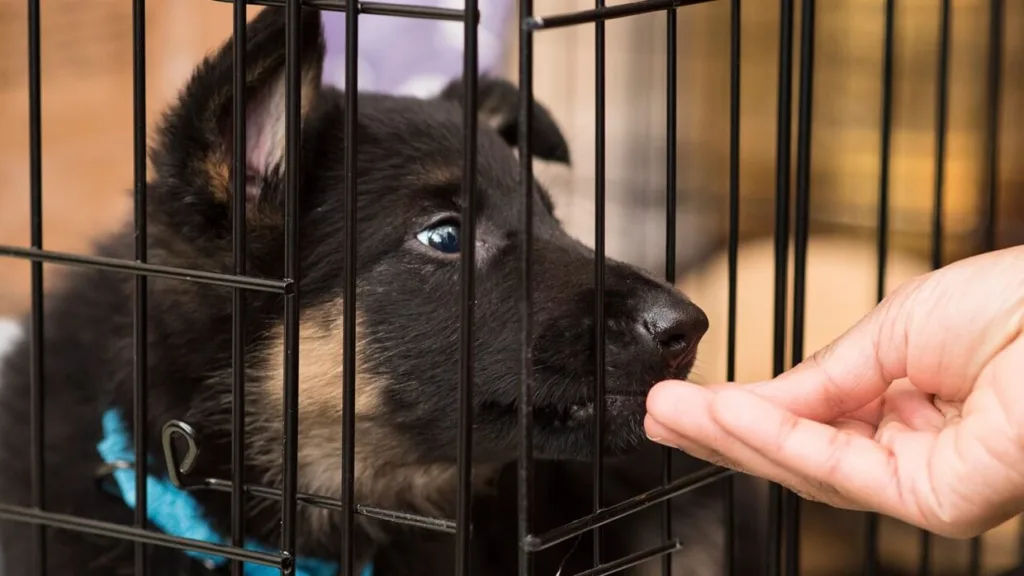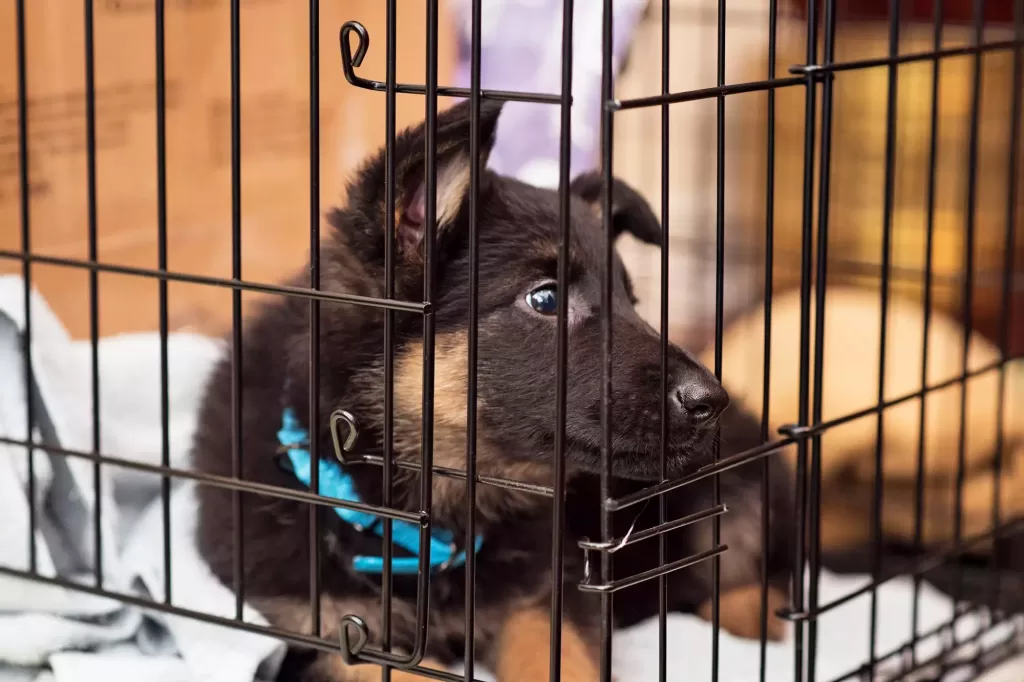Crate Train Your Puppy: Crate training has many advantages and benefits for both dogs and their owners. So, it’s no surprise that most pet parents choose to crate-train their furry friends.
Read this guide to learn creative ways to crate-train your gorgeous new puppy!
First Steps
Before you collect your new puppy, you’ll need to get your crate ready for him so as to Crate Train Your Puppy. That way, you can begin the crate training process immediately rather than letting the little guy settle into his new life and then have to change things.
Choose A Crate
There are several different kinds of crates to choose from, including:
- Metal mesh crates
- Plastic travel crates
- Furniture crates
- Soft-sided fabric crates
You can also buy heavy-duty, escape-proof metal crates. However, we recommend starting out with a basic metal mesh crate. Ideally, you should pick a crate that comes with a divider. That enables you to adjust the crate size as your puppy grows and can make potty training easier.
Also Read: Why Your Dog Should Be On Leash In Public Areas
The crate must be large enough for your puppy to comfortably stand up, lie down, turn around, and sit down without bumping into the crate’s roof or sides.
Position The Crate
Place the crate somewhere quiet and calm, out of draughts and direct heat, and not in a busy foot traffic lane.
Make The Crate Comfortable

Cover the crate to create a den-like, peaceful space. Use a proper crate cover rather than a blanket.
Equip the crate with a comfy bed and a couple of interactive toys that your puppy can play with.
Potty Stop!
The first thing to do when you arrive home with your new puppy is to take him outside for a potty stop and a run-around. Any form of training is always easier when your dog isn’t full of excess energy and has had a chance to relieve himself.
Positive Reinforcement

When training your puppy, always use positive reinforcement training methods. Never punish your puppy during the training process, or you risk him associating the crate with negativity.
Crate Training Your Puppy
Crate training is sometimes easier if you have a multi-dog household. Crate training with other dogs can give a new puppy the confidence he needs, especially if he can see his housemates happily using their crates.
Reward-Based Training
Take your puppy back into the house and sit down near the crate. Call your puppy to you and reward him with a few treats.
Now, leave a trail of high-value treats leading into your puppy’s crate. The treats inside the crate must be super-tasty and tempting!
Toss a treat close to the crate and let your puppy go to grab it. Repeat that process encouraging the puppy to get closer and closer to the crate. Soon, your dog will begin following the treat trail you set earlier.
Don’t force your puppy to go into the crate. Allow him to investigate the crate in his own time.
Repeat the treat “game” a few times each day.
Allow your puppy to see you putting his favorite treats inside the crate. Shut the door so that the pup can see and smell the treats but can’t get to them. Soon, he will be scratching at the crate door to get inside!
Next Steps
- Put a fun chew toy at the back of the crate so that your puppy gets a nice surprise if he ventures inside.
- Try feeding your puppy his meals inside the crate. Leave the door open so that your pet can leave the crate after he’s finished eating if he wants to.
- Once your puppy is going into the crate happily, introduce a verbal cue, such as “crate,” every time your pet enters the crate.
- Immediately reward your dog when he goes into the crate by pushing treats through the crate roof. Close the door while your puppy is eating the treats.
Be Consistent
For your training to succeed, you and your family must be consistent in your approach. Keep repeating the exercises to teach your dog that his crate is a fun, tasty place to be and should be his go-to spot when he wants to relax and chill out with a chew toy.
It’s critical that the crate is viewed as a rewarding place for your pet to spend his time. If the crate ceases to be rewarding and fun, your puppy will soon lose interest, and his desire to spend time in his crate will dwindle.
So, keep the crate comfy and clean, and remember to add plenty of treats.
Top Tips To Remember
Once the basics of crate training your puppy are in place, you can try relocating the crate to different spots in your home.
Remember that the crate’s location must be quiet, warm but not too hot, and out of draughts. That’s good preparation for times when you take your puppy on vacation with you or when you go visiting friends.
TV or background music can help mask external sounds that could overexcite or upset your puppy.
Final Thoughts
I hope you enjoyed our guide to some creative ways you can use to crate train your puppy. If you found the article helpful, don’t forget to share it before you leave!
Crate training a puppy should be a positive experience for all parties involved in the process. Use reward-based methods to persuade your new furry friend to view his crate as a happy, comfy place where he wants to spend his downtime. Don’t force your puppy to go into the crate, and never use the crate as a punishment tool.

